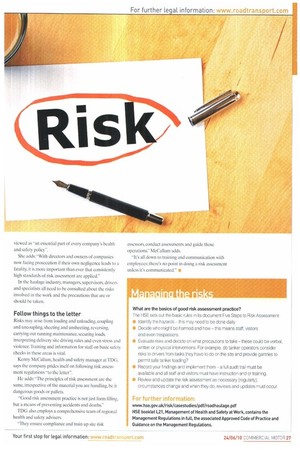Reducing the margin for error
Page 26

Page 27

If you've noticed an error in this article please click here to report it so we can fix it.
Operators that fail to manage workplace risks can face huge penalties and even jail sentences.
Words: Roger Brown The tragic case of a truck driver killed at a waste management site demonstrates how important it is for haulage firms to have robust risk assessment procedures in place.
In a prosecution brought by the Health and Safety Executive (HSE). SITA UK was fined £210,000 after Gary Carter. 32, was crushed to death between his truck and a bulldozer at the company's landfill site in Cranford near Kettering, Northants. in January 2007 (CM3 June).
SITA pleaded guilty last month at Northampton Crown Court to breaching Section 3(1) of the Health and Safety at Work Act 1974 and was also ordered to pay full costs of £38,000.
Gary Carter — who was not employed by SITA — was in a truck that had become bogged down in soft ground.
A compactor driver radioed to him to say he would drive up behind and give the lorry a push forward, while at the same time, the bulldozer reversed up to the front of Carter's cab to give him a tow.
When Carter was attaching a tow rope from the bulldozer to the front of his truck, the compactor started to push it forward, which crushed him between his vehicle and back of the bulldozer. Following CM's story earlier this month, Gary's father, Peter, contacted CM to say that the inquest heard the radio contact did not take place.
Roy Bush, HSE inspector, says every company has a legal responsibility to take care of people working on their site, "whether they are employed by them or not".
All companies are required to assess risks, eliminate them where possible and provide proper control measures to deal with the risks that remain.he adds.
"Having clear site rules that deal with the significant risks on site and making sure staff understand them and stick to them is absolutely vital if people on sites like this are to be protected from serious injury and even death."
SITA had not defined the supervisory roles for staff at the facility and site rules on pushing trucks were ambiguous.
Also, new working arrangements had been introduced a few days before the accident without having been properly risk-assessed. The general requirements for risk assessments are contained in the Management of Health and Safety at Work Regulations 1999 (Management Regulations), Regulation 3.
Other regulations, which require more specific types of risk assessment, include: • Control of Substances Hazardous to Health Regulations 2002 (COSHH) • Manual Handling Operations Regulations 1992 • Control of Noise at Work Regulations 2005 • Personal Protective Equipment at Work Regulations 1992 The maximum penalty for a breach of the rules at a Magistrates' Court hearing is £20,000, while in the Crown Court unlimited fines and even imprisonment are possible.
Freight Transport Association (FTA) head of consultancy Karen Packham believes "prevention is far better than cure" and that risk assessments should be viewed as "an essential part of every company's health and safety policy".
She adds: "With directors and owners of companies now facing prosecution if their own negligence leads to a fatality, it is more important than ever that consistently high standards of risk assessment are applied."
In the haulage industry, managers, supervisors, drivers and specialists all need to be consulted about the risks involved in the work and the precautions that are or should be taken, Follow things to the letter Risks may arise from loading and unloading, coupling and uncoupling, sheeting and unsheeting, reversing, carrying out running maintenance, securing loads, interpreting delivery site driving rules and even stress and violence. Training and information for staff on basic safety checks in these areas is vital.
Kenny McCallum, health and safety manager at TDCi. says the company prides itself on following risk assessment regulations "to the letter".
He adds: "The principles of risk assessment are the same, irrespective of the material you are handling, be it dangerous goods or pallets.
"Good risk assessment practice is not just form tilling, but a means of preventing accidents and deaths."
TDG also employs a comprehensive team of regional health and safety advisers "They ensure compliance and train up site risk assessors, conduct assessments and guide those operations," McCallum adds.
"It's all down to training and communication with employees; there's no point in doing a risk assessment unless it's communicated." •












































































































































